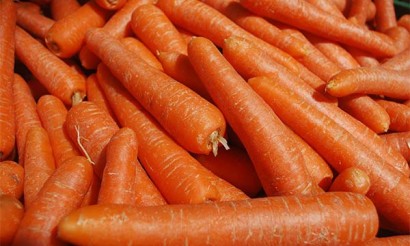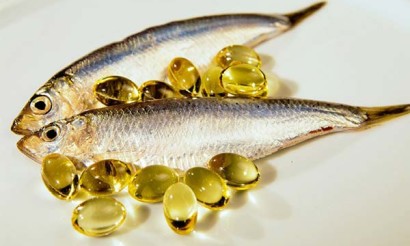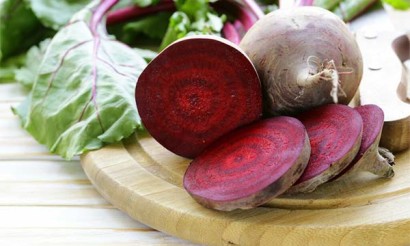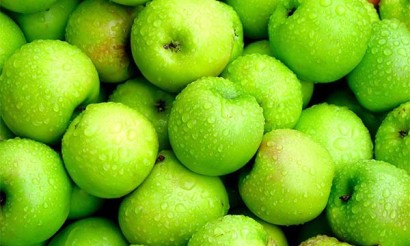String beans during breastfeeding: benefits and harms
String beans are a very valuable natural product. In terms of protein content, it can compete with meat and fish. Unfortunately, most breastfeeding mothers are wary of this natural source of vitamins and mineral elements. But pediatricians and nutritionists advise women during the breastfeeding period necessarily include green beans in their diet.
- Can you eat string beans while breastfeeding
- The first month
- The second month
- How to eat green beans correctly
- How much can I eat per day?
- Can they be eaten at bedtime and on an empty stomach?
- Which product to choose?
- The benefits of green beans when breastfeeding
- What are the dangers of string beans during lactation
- How to correctly introduce green beans into the diet of a nursing mother
- Recipes for cooking string beans
- Light salad
- Cream soup with beans
- Vegetable Stew
- Side dish recipe
- Dietary recommendations
Such a nutritious supplement will benefit the mother herself and the growing baby. True, there are some nuances associated with the special properties of all legumes. Eliminate acute points and balance the daily menu will help this article, in which we will tell you how to properly introduce beans in pods in the diet of a nursing mother, what nutritious dishes can be prepared from this legume culture.
Can I eat green beans while breastfeeding?
Strict requirements for the diet of a nursing woman is due, first and foremost, the need to reduce any risks to the health of the newborn baby. After all, any unfamiliar product can provoke the most unexpected consequences. Especially dangerous are the changes in the diet of the mother in the first few months of life of the baby. So all changes in diet should be made with extreme caution, and under medical supervision.
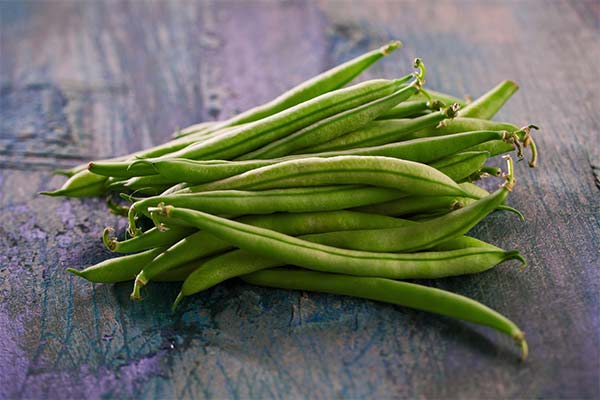
Of course, if you take the simplest way, which is to eat only dairy products, you can exclude all the risks. But the developing body of the baby needs a constant supply of minerals and vitamins, and milk can not provide this amount of substances. Therefore, the mother's diet should be periodically supplemented with healthy foods. String beans can enrich milk with a valuable complex of substances that will be equally useful for mother and baby. Even pediatricians have a positive attitude toward the inclusion of dishes with beans in the diet. The only thing that is strictly forbidden for breastfeeding women is the use of raw beans. The fact that the tough fiber of the raw pods can cause severe digestive disorders in the mother and baby.
In the first month
In the first months of life, the baby's digestive system is not yet ready to process complex foods. Therefore, mom should not introduce beans and other leguminous cereals into her diet. Even after heat treatment, beans may provoke painful colic in the baby's tummy, increased gas production, uncontrollable diarrhea and vomiting.
In the second month.
Nutritionists and pediatricians believe that the most convenient time for the appearance of string beans in the menu of a nursing woman is at the end of the fourth month of the baby's life. A two-month-old baby still has underdeveloped secretory functions and the "native" intestinal microflora is not fully formed. For this reason, the baby's digestive tract is simply not ready to accept and process food such as beans.
How to eat green beans correctly
All legumes have one negative ability - they increase gas. For this reason, many people include beans in the "black list", forgetting that the correct consumption of this valuable product will completely eliminate all the side effects. Dishes with beans are tasty and nourishing. The pods and the beans themselves contain a huge supply of components necessary for a nursing woman, such as folic acid. In addition, green beans in pods stimulate lactation, which is very important during the breastfeeding period. The main thing is to observe the rate of consumption and prepare the "right" dishes.
How much you can eat per day
Young bean pods contain a huge supply of mineral elements and almost all vitamins. This means that in one small grain dozens of individual substances are concentrated, and they also have complex organic compounds. And each component, once in the body, performs strictly assigned tasks. Taking into account that each pod may contain 6-15 fruits, it is not difficult to imagine the potential hidden behind the green pods. But we know that over-abundance is just as bad as under-abundance. Therefore, overindulging in beans while breastfeeding can lead to unpleasant consequences.
The maximum allowable daily rate of string beans - 20 pods, but at first the portion should not exceed 4-5 pieces. It was mentioned above that a woman can introduce a legume product into her diet not earlier than four months after childbirth. If the baby responds well to the new product, then you can gradually increase the portion and add new dishes to the menu. Of course, dishes of string beans should appear on the table of a nursing mother not more than three times a week.
Can I eat at night and on an empty stomach
Boiled beans are best eaten in the first half of the day, and ideally - for breakfast. On an empty stomach, dishes from legumes should not be eaten, because it can provoke the development of gastrointestinal disorders. Before going to bed, because of its special properties, beans should not be eaten even in minimal quantities.
What product to choose
Of course, the main question is how to choose the right beans in pods for the diet of a nursing woman. The legume family is one of the most numerous groups. There are more than 90 species of beans alone. All varieties have distinctive characteristics both in the shape and color of the pods, and in the number of grains in them. Green beans are optimal for the diet of women in the period of active lactation, because they are less caloric and full of fiber. Due to this combination of characteristics, unripe bean pods are considered to be a suitable product for the nutrition of mothers. Therefore, experts recommend that you begin your acquaintance with leguminous cereals exactly with string beans. Now let's focus on which product to choose.
Of course, it is best to prepare dishes from fresh pods. But such an opportunity is presented only closer to the fall in the harvest season.
Today stores often sell frozen pods. This product can also be eaten, as long as the pods are of good quality and undamaged.
Canned beans are much less effective than fresh beans because they lose about 30% of their nutritional value during processing. In addition, industrial canning uses various additives that are not safe for the health of the mother and baby.
When choosing canned beans, you should pay attention to the following criteria:
- shelf life;
- Absence of turbid sediment (if the vegetable products are in glass jars);
- pods of approximately the same size;
- no bloating of the lid - this is the main indicator of quality;
- composition: in addition to beans, the presence of salt, water and sugar is allowed.
Important point: canned product with the addition of vinegar and tomato paste is not suitable for the diet of a nursing woman.
The benefits of string beans when breastfeeding
String beans are ideal for dietary nutrition. Perfectly balanced composition of the natural product allows you to prepare from it a variety of dishes.
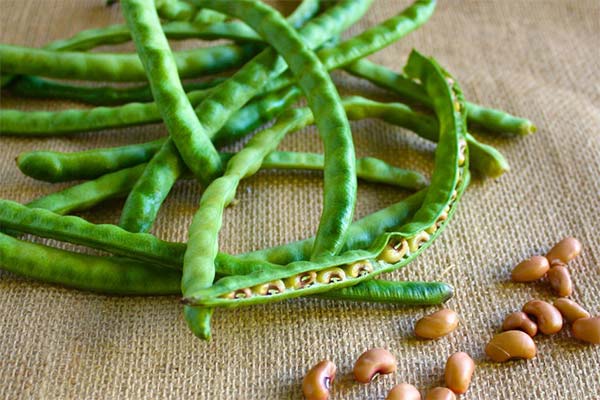
In addition to nutritional purposes, beans are an excellent cosmetic agent. For example, beans can be used to make nourishing masks, and dried grains were used to make powder.
Most of all string beans, like other legumes, are valued for their high protein content. In the first year of his life, the child is actively growing and gaining weight. Important organs and systems are formed in his body and brain activity is activated. All these processes need the resources that can provide a young bean. The composition of the grains and pods, in addition to proteins, contains the following useful substances:
- Plant fibers in large quantities.
- Vitamin complex, including B vitamins, tocopherol, ascorbic acid and folic acid, as well as other substances from this group.
- Mineral elements: iron, copper, sulfur, zinc, magnesium and many more.
- Carotenes.
- Amino acids, including essential ones.
- Fats and sugars.
All these components are equally useful for a nursing woman and a growing baby. The presence in the menu of dishes with young bean pods will have the following positive effects:
- help strengthen the immune system;
- Improve digestion;
- normalizes the work of the intestines;
- prevent the development of anemia;
- Strengthen bones and muscles;
- normalize hormonal background of women after childbirth;
- It will benefit the cardiovascular system.
One can list the possibilities of this unique product for a long time, but most women can quickly restore the normal weight and improve their appearance with its help. After all, beans contain everything that can refresh the skin and strengthen the nails and hair.
And the last argument in favor of young beans - the caloric value of 100 grams of product in fresh form is only 23 units. This data refutes the myth that beans promote weight gain. On the contrary, the presence in the diet of such a low-calorie product will help women quickly normalize their figure.
It is useful to know: If a breastfeeding mother eats bean dishes regularly, the baby will be teething in time.
What are the dangers of string beans during lactation?
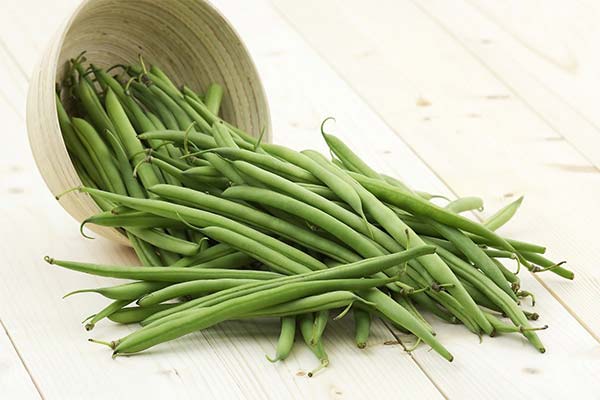
From the above description it follows that green beans are a valuable and nutritious food product. But under certain circumstances, it should not be consumed by women during lactation. The list of contraindications includes:
- peptic ulcer disease;
- colitis;
- gout;
- gastritis;
- nephritis;
- pancreatitis;
- cholecystitis.
If a woman has one of these pathologies, it is strictly forbidden to add beans to her diet. Also consider the susceptibility of the baby to beans. If the first experience of using beans in pods caused a child's allergy, should be postponed from the introduction to the diet of this product.
Special Guidelines
- Even moderate portions of string beans can provoke bloating in the child and colitis. Therefore, at the first signs of a painful condition, you should immediately give up dishes with this product.
- Beans in pods, like asparagus, contain phytic acid. This organic compound in large quantities reduces the absorption of nutrients.
- Particular caution should be introduced into the diet of leguminous grains to women who have had a Caesarean section.
How to properly introduce green beans into the diet of a nursing mother
You need to understand that the time of breastfeeding is not suitable for experimentation. Each new product in the mother's diet should be introduced gradually, in small portions. There is an opinion that if a woman regularly consumed beans before pregnancy, the risk of side effects is minimized. But still, if you want to expand your diet, you should follow these rules:
- It is better to start with boiled beans.
- Five pods are enough for the first try.
- You can begin to introduce beans into the diet when the baby is three months old, but not before.
- At the slightest deviation in the baby's health, you need to postpone introduction to the new product for a couple of weeks.
- Meals made of beans is best eaten at breakfast after feeding the child in the morning, but not on an empty stomach.
- If the baby is not noticed abnormalities, after two days, you can eat some beans again in a boiled or stew.
- Increase the portion should be gradual, literally a pod once a week, but the allowable dose per day should not exceed 20 pieces.
If you follow these rules, then acquaintance not only with beans in pods, but also with other products, will pass without complications.
Cooking recipes for green beans
During the lactation period, it is not only the quality and usefulness of the food that matters, but also how the food is prepared. Because raw beans are strictly forbidden for breastfeeding moms, experts recommend boiling or steaming the vegetable. Fried beans should not appear on a woman's table either, because such food is not suitable for the infant's digestive system. Otherwise, you can prepare from young bean pods nutritious and useful dishes that will bring variety to the strict diet of a nursing woman.

What can be cooked from the bean pods
Young beans in pods are perfectly combined with meat and any vegetables. They are especially good in combination with cabbage. The following dishes can be made with beans:
- soups:
- salads;
- side dishes;
- mashed potatoes;
- vegetable stews.
Canned homemade beans can be used as a filling for pies.
Here are recipes for the best dishes with string beans that breastfeeding moms can include in their daily diet.
Easy salad
The recipe for this tasty salad is very popular. Preparation of the dish does not require much time, but it turns out a great and nourishing snack.
Set of products:
- carrot - 1 pc;
- beans in pods - 2 handfuls;
- apple cider vinegar - 2 tablespoons;
- olive oil - 2 tablespoons;
- parsley - a few sprigs;
- salt, ground pepper - on the tip of a knife.
How to cook:
- Rinse and boil the vegetables well.
- Carrots cut into circles, bean pods also divide into several parts.
- Finely chop the greens.
- Mix all ingredients, salt, add pepper, vinegar and oil.
- Mix the salad and stir it well.
Then you can enjoy the taste of a nutritious dish.
Cream soup with beans
This everyday dish is excellent for the diet of a nursing woman.
To prepare it, you will need:
- green beans - 0, 5 kg;
- vegetable or chicken broth - 500 ml;
- carrot - 1 pc;
- potatoes - a few tubers;
- salt, pepper - to taste;
- Chopped greens - as desired.
Cooking process:
- In the ready broth to put first the bean pods, diced carrots and potatoes.
- All boil for 10 minutes.
- Then turn the boiled vegetables with a blender into a puree.
- Combine the two parts of the dish, add salt and pepper.
You can proceed to tasting the fragrant first dish with beans.
A vegetable stew
And this amazing dish will be tasty not only for the nursing woman, but also for the rest of the family. Given the healthy potential of vegetable stew involving young bean pods, it is quite possible to include it in the daily diet. To prepare the stew, you will need the following product set:
- cauliflower - 1/2 a cabbage;
- tomatoes - 2 medium fruits;
- Beets - 1 root vegetable;
- Onion - 1 head;
- carrot - 1 pc;
- green beans - 1/2 kg;
- Eggplant - 1 pc.
When all the vegetables are prepared, you can begin the cooking process:
- First, cut the vegetables in any arbitrary shape. Cabbage is divided into florets.
- In a suitable dish, greased with olive oil, put the vegetable mass, except for the tomatoes and beans.
- Then send the dish to a preheated oven.
- At a temperature of 130 degrees cook the dish for about 20 minutes. The stew should not be brought to complete readiness.
- After the specified time, add the bean pods and tomatoes to the vegetables.
- After that, transfer the half-cooked stew to another pot, and simmer on low heat until it is fully cooked.
Recipe for side dish
In principle, this version of the dish slightly resembles the previous recipe, but the only difference is that in this case, the string beans are cooked without adding other vegetables.
The sequence of culinary actions:
- For 1.5 liters of water take 1/2 kg of young bean pods.
- Soak the beans in cold water for a couple of hours. If you use frozen product, soaking is not necessary.
- Then in a separate bowl bring the specified amount of water to a boil, add salt, beans and spices.
- Boil for 5-10 minutes until the beans are soft.
- Half boiled beans again put for a minute in a bowl of cold water.
- Drain the water.
Such a side dish will go with fish and meat, but you can use it as a separate dish.
Dietary recommendations
With the participation of green bean pods you can prepare a lot of useful dishes for mother and child. But, wanting to make bright accents in their own menu, a nursing woman should remember some useful tips:
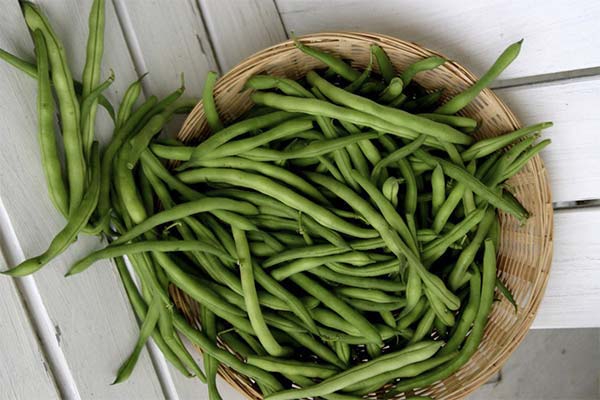
- Bean soup can be included in the menu no more than twice a week.
- Dish made of beans should not be eaten in the afternoon, because they take quite a long time to process.
- Red beans in pods, although they contain more iron, can provoke an allergic reaction.
- At first it is better to prepare the soup with plain water or vegetable broth.
- It is undesirable to combine beans and meat in one bowl. It is better to use these products separately.
- Roasting vegetables in soup is inadmissible, because such a supplement will cause upset stools and colic in the child.
- Beans are good at absorbing water, so for first courses you need to take 2 or 3 times as much liquid for one part of the beans.
- String beans should be boiled for no more than 5-10 minutes and steamed for a quarter of an hour.
- Soak the bean pods is necessary if they are used fresh.
Following the rules listed here will help mom to cope with cooking tasks on a daily basis, and the baby - to grow up healthy and strong.
Conclusion
Not only does every mom give her baby life, she shapes her nutritional habits. Through mother's milk, the little man learns the harmony of tastes and flavors. Food is essential for every human being, because it contains everything without which life itself is impossible. Therefore, every loving mother should gradually open the door to this world for her baby. Beans are a unique product in its structure and composition. The perfectly balanced composition of each grain will bring maximum benefit to the baby, will help the mother to overcome the difficulties of the period of breastfeeding.
«Important: All the information on the site is provided solely for informational purposes only. Please consult a health care professional before using any recommendations. specialist before you use any of the recommendations. Neither the editors nor the authors shall be held liable for any possible harm caused by materials."



